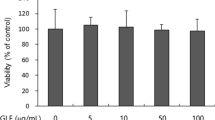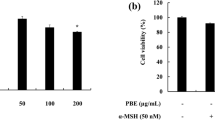Abstract
Natural products with non-toxic and environmentally friendly properties are good sources for skin-whitening and brightening cosmetic agents. Strawberries (Fragaria ananassa), and their parts are used as cosmetic agents, because they contain high levels of bioactive substances. We isolated and identified compounds from F. ananassa calyx. Oleanolic acid has multiple biological activities, including anti-tumor, anti-angiogenic, antiinflammatory, anti-oxidant, and pro-apoptotic effects. However, no study has investigated the influence of oleanolic acid on melanin synthesis in B16-F10 melanoma cells. In the present study, we investigated the effect of oleanolic acid on melanin biosynthesis in B16-F10 melanoma cells stimulated with α-melanocyte stimulating hormone (α-MSH). Oleanolic acid-mediated melanogenesis inhibition was studied by measuring intracellular and secreted melanin levels and by using Western blot and semiquantitative reverse transcriptase-polymerase chain reaction analyses. Oleanolic acid suppressed melanin release and expression, resulting in a significant dose-dependent decrease in secreted and intracellular melanin levels and cellular tyrosinase activity. Furthermore, it inhibited the expression of melanogenesis-associated factors, including tyrosinase, tyrosinase-related proteins-1 and -2, and microphthalmia-associated transcription factor, in α-MSH-stimulated B16-F10 melanoma cells. The results of the present study can contribute to the development of cosmetic agents utilizing the skin whitening and brightening effect of oleanolic acid, which will likely have a wide range of applications in the cosmetic industry and/or clinical practice in the future.
Similar content being viewed by others
References
Andersson D, Liu JJ, Nilsson A, and Duan RD (2003) Ursolic acid inhibits proliferation and stimulates apoptosis in HT29 cells following activation of alkaline sphingomyelinase. Anticancer Res 23, 3317–22.
Ando H, Kondoh H, Ichihashi M, and Hearing VJ (2007) Approaches to identify inhibitors of melanin biosynthesis via the quality control of tyrosinase. J Invest Dermatol 127, 751–61.
Baek JH and Lee SH (2010) Isolation and molecular cloning of venom peptides from orancistrocerus drewseni (hymenoptera: Eumenidae). Toxicon 55, 711–8.
Bellei B, Flori E, Izzo E, Maresca V, and Picardo M (2008) GSK3-β inhibition promotes melanogenesis in mouse B16 melanoma cells and normal human melanocytes. Cell Signal 20, 1750–61.
Cijo George V, Naveen Kumar D, Suresh P, and Kumar RA (2014) Oleanolic acid inhibits cell growth and induces apoptosis in A375 melanoma cells. Biomedicine & Preventive Nutrition 4, 95–9.
Cui T, Li J, Kayahara H, Ma L, Wu L, and Nakamura K (2006) Quantification of the polyphenols and triterpene acids in chinese hawthorn fruit by high-performance liquid chromatography. J Agric Food Chem 54, 4574–81.
Del Marmol V and Beermann F (1996) Tyrosinase and related proteins in mammalian pigmentation. FEBS Lett 381, 165–8.
Giampieri F, Tulipani S, Alvarez-Suarez JM, Quiles JL, Mezzetti B, and Battino M (2012) The strawberry: Composition, nutritional quality, and impact on human health. Nutrition 28, 9–19.
Gillbro J and Olsson M (2011) The melanogenesis and mechanisms of skinlightening agents-existing and new approaches. Int J Cosmetic Sci 33, 210–21.
Hearing VJ and Jiménez M (1987) Mammalian tyrosinase- the critical regulatory control point in melanocyte pigmentation. Int J Biochem 19, 1141–7.
Hearing VJ, Korner AM, and Pawelek JM (1982) New regulators of melanogenesis are associated with purified tyrosinase isozymes. J Invest Dermatol 79, 16–8.
Jang S, Yee S, Choi J, Choi M, Do G, Jeon S, Yeo J, Kim M, Seo K, and Lee M (2009) Ursolic acid enhances the cellular immune system and pancreatic -β-cell function in streptozotocin-induced diabetic mice fed a high-fat diet. Int Immunopharmacol 9, 113–9.
Karlund A, Salminen JP, Koskinen P, Ahern JR, Karonen M, Tiilikkala K, and Karjalainen RO (2014) Polyphenols in strawberry (fragaria × ananassa) leaves induced by plant activators. J Agric Food Chem 62, 4592–600.
Kim D, Baek JH, Kang C, Yoo M, Sung J, Kim D, Chung H, Kim ND, Choi YH, and Lee S (2000) Apoptotic activity of ursolic acid may correlate with the inhibition of initiation of DNA replication. Int J Cancer 87, 629–36.
Kuzumaki T, Matsuda A, Wakamatsu K, Ito S, and Ishikawa K (1993) Eumelanin biosynthesis is regulated by coordinate expression of tyrosinase and tyrosinase-related protein-1 genes. Exp Cell Res 207, 33–40.
Langan E, Nie Z, and Rhodes L (2010) Melanotropic peptides: More than just ‘Barbie drugs’ and ‘suntan jabs’? Br J Dermatol 163, 451–5.
Levy C, Khaled M, and Fisher DE (2006) MITF: Master regulator of melanocyte development and melanoma oncogene. Trends Mol Med 12, 406–14.
Liu J (1995) Pharmacology of oleanolic acid and ursolic acid. J Ethnopharmacol 49, 57–68.
Liu J (2005) Oleanolic acid and ursolic acid: Research perspectives. J Ethnopharmacol 100, 92–4.
Mishima Y (1994) Molecular and biological control of melanogenesis through tyrosinase genes and intrinsic and extrinsic regulatory factors. Pigment Cell Res 7, 376–87.
Mitani K, Takano F, Kawabata T, Allam AE, Ota M, Takahashi T, Yahagi N, Sakurada C, Fushiya S, and Ohta T (2013) Suppression of melanin synthesis by the phenolic constituents of sappanwood (caesalpinia sappan). Planta Med 79, 37–44.
Mountjoy KG, Robbins LS, Mortrud MT, and Cone RD (1992) The cloning of a family of genes that encode the melanocortin receptors. Science 257, 1248–51.
Munoz C, Hoffmann T, Escobar NM, Ludemann F, Botella MA, Valpuesta V, and Schwab W (2010) The strawberry fruit fra a allergen functions in flavonoid biosynthesis. Mol Plant 3, 113–24.
Niikawa M, Hayashi H, Sato T, Nagase H, and Kito H (1993) Isolation of substances from glossy privet (Ligustrum lucidum Ait.) inhibiting the mutagenicity of benzo[a]pyrene in bacteria. Mutation Research/Genetic Toxicology 319, 1–9.
Ovesna Z, Vachalkova A, Horvathova K, and Tothova D (2004) Pentacyclic triterpenoic acids: New chemoprotective compounds. minireview Neoplasma 51, 327–33.
Parvez S, Kang M, Chung H, Cho C, Hong M, Shin M, and Bae H (2006) Survey and mechanism of skin depigmenting and lightening agents. Phytother Res 20, 921–34.
Perez-Bernal A, Muñoz-Pérez MA, and Camacho F (2000) Management of facial hyperpigmentation. Am J Clin Dermatol 1, 261–8.
Plonka PM and Grabacka M (2006) Melanin synthesis in microorganisms-biotechnological and medical aspects. Acta Biochim Pol 53, 429–43.
Prota G (1988) Progress in the chemistry of melanins and related metabolites. Med Res Rev 8, 525–56.
Scott MC, Wakamatsu K, Ito S, Kadekaro AL, Kobayashi N, Groden J, Kavanagh R, Takakuwa T, Virador V, Hearing VJ, and Abdel-Malek ZA (2002) Human melanocortin 1 receptor variants, receptor function and melanocyte response to UV radiation. J Cell Sci 115, 2349–55.
Shigeta Y, Imanaka H, Ando H, Ryu A, Oku N, Baba N, and Makino T (2004) Skin whitening effect of linoleic acid is enhanced by liposomal formulations. Biol Pharm Bull 27, 591–4.
Takada K, Nakane T, Masuda K, and Ishii H (2010) Ursolic acid and oleanolic acid, members of pentacyclic triterpenoid acids, suppress TNF- a-induced E-selectin expression by cultured umbilical vein endothelial cells. Phytomedicine 17, 1114–9.
Tuerxuntayi A, Liu Y, Tulake A, Kabas M, Aiden E, and Aisa HA (2014) Kaliziri extract upregulates tyrosinase, TRP-1, TRP-2 and MITF expression in murine B16 melanoma cells. BMC Complementary and Alternative Medicine 14, 166.
Virador V, Matsunaga N, Matsunaga J, Valencia J, Oldham RJ, Kameyama K, Peck GL, Ferrans VJ, Vieira WD, and AbdelMalek ZA (2001) Production of MelanocyteSpecific antibodies to human melanosomal proteins: Expression patterns in normal human skin and in cutaneous pigmented lesions. Pigment Cell Res 14, 289–97.
Author information
Authors and Affiliations
Corresponding authors
Rights and permissions
About this article
Cite this article
Han, S.K., Kim, Y.G., Kang, H.C. et al. Oleanolic acid from Fragaria ananassa calyx leads to inhibition of α-MSH-induced melanogenesis in B16-F10 melanoma cells. J Korean Soc Appl Biol Chem 57, 735–742 (2014). https://doi.org/10.1007/s13765-014-4225-7
Received:
Accepted:
Published:
Issue Date:
DOI: https://doi.org/10.1007/s13765-014-4225-7




